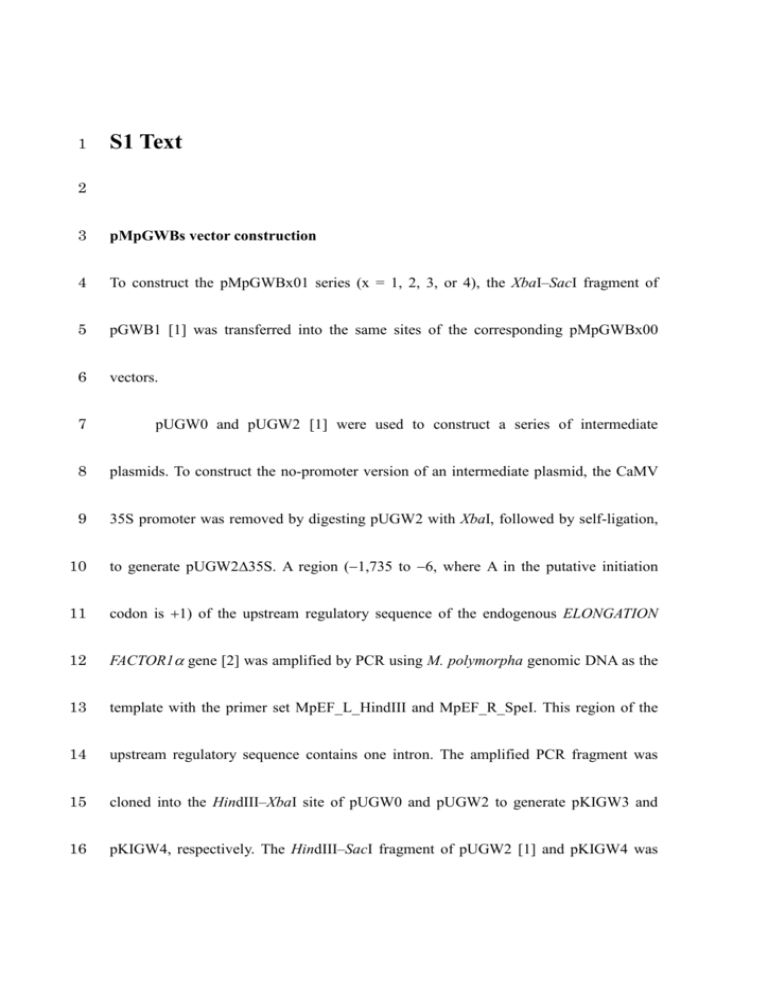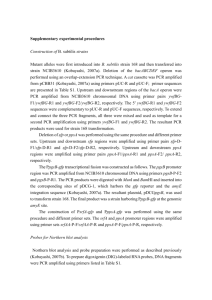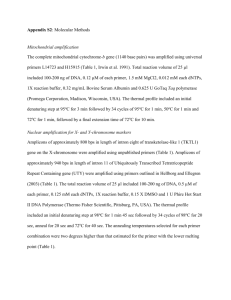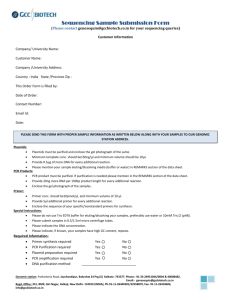S1 Text - Figshare
advertisement

1 S1 Text 2 3 pMpGWBs vector construction 4 To construct the pMpGWBx01 series (x = 1, 2, 3, or 4), the XbaI–SacI fragment of 5 pGWB1 [1] was transferred into the same sites of the corresponding pMpGWBx00 6 vectors. 7 pUGW0 and pUGW2 [1] were used to construct a series of intermediate 8 plasmids. To construct the no-promoter version of an intermediate plasmid, the CaMV 9 35S promoter was removed by digesting pUGW2 with XbaI, followed by self-ligation, 10 to generate pUGW235S. A region (1,735 to 6, where A in the putative initiation 11 codon is 1) of the upstream regulatory sequence of the endogenous ELONGATION 12 FACTOR1 gene [2] was amplified by PCR using M. polymorpha genomic DNA as the 13 template with the primer set MpEF_L_HindIII and MpEF_R_SpeI. This region of the 14 upstream regulatory sequence contains one intron. The amplified PCR fragment was 15 cloned into the HindIII–XbaI site of pUGW0 and pUGW2 to generate pKIGW3 and 16 pKIGW4, respectively. The HindIII–SacI fragment of pUGW2 [1] and pKIGW4 was 17 transferred into the same sites of the corresponding pMpGWBx00 vectors to generate 18 the pMpGWBx02 and pMpGWBx03 series, respectively. 19 The pMpGWBx04 series containing the GUS reporter were constructed by 20 transferring the HindIII–SacI fragment of pGWB3 [1] into the same sites of the 21 corresponding pMpGWBx00 vectors. 22 The coding sequence of Citrine [3] (kindly provided by Roger Y. Tsien, 23 University of California at San Diego) was amplified by PCR with the primer set 24 Citrine_L and Citrine_Rns, and cloned into the Aor51HI site of pUGW0 to construct 25 pKIGW5. Similarly, the coding sequence of Citrine was amplified by PCR with the 26 primer set Citrine_L and Citrine_Rs and cloned into the Aor51HI site of pUGW2 and 27 pUGW235S to construct pKIGW6 and pKIGW7, respectively. Finally, the coding 28 sequence of Citrine with a GGSGGS linker sequence at the N-terminus was amplified 29 by PCR with pUGW2-GGS2-FP_IF_F and pUGW2-FP_IF_R and cloned into the 30 Aor51HI site of pKIGW4 using an In-Fusion HD cloning kit (Clontech) to construct 31 pKRN38. The HindIII–SacI fragment of pKIGW5, pKIGW6, and pKIGW7 was 32 transferred into the same sites of the corresponding pMpGWBx00 vectors to generate 33 the pMpGWBx05, pMpGWBx06, and pMpGWBx07 series, respectively. The HindIII– 34 HindIII fragment (second HindIII site was accidentally generated in the primer 35 pUGW2-FP_IF_R) of pKRN38 was transferred into the HindIII site of the 36 corresponding pMpGWBx00 vectors to generate the pMpGWBx08 series. 37 The coding sequence of 3FLAG (DYKDHDGDYKDHDIDYKDDDDK) was 38 amplified by PCR with the phosphorylated primer set 3FLAG_F and 3FLAG_SacI_R, 39 digested with SacI, and then cloned into the Aor51HI–SacI sites of pUGW235S, 40 pKIGW4, and pUGW2. The HindIII–SacI fragment of the resulting plasmids was 41 transferred into the same sites of the pMpGWBx00 vectors to generate the 42 pMpGWBx09, pMpGWBx10, and pMpGWBx11 series, respectively. 43 The GR coding sequence was amplified by PCR using a plasmid containing 44 LhGR fragment [4] as the template with the phosphorylated primer set GR_L and 45 GR_SacI_R2, digested with SacI, and then cloned into the Aor51HI–SacI sites of 46 pUGW235S, pKIGW4, and pUGW2. Two HindIII sites within the GR sequence in the 47 resulting plasmids were destroyed with synonymous substitutions using PCR-based 48 site-directed mutagenesis sequentially with two primer sets; GR_mHind_F and 49 GR_mHind_R, and GR_mHind_F2 and GR_mHind_R3. The HindIII–SacI fragment of 50 the modified plasmids was transferred into the same sites of the pMpGWBx00 vectors 51 to generate the pMpGWBx12, pMpGWBx13, and pMpGWBx14 series, respectively. 52 The coding sequences of Citrine with the SV40 NLS sequence at the C-terminus 53 (Citrine-NLS) and its tdTomato [5] version (tdTomato-NLS) were both amplified by 54 PCR with the phosphorylated primer set YFP-ATG-F-070724 and tdTomato_NLS_R, 55 digested with SacI, and then cloned into the Aor51HI–SacI sites of pUGW235S. The 56 HindIII–SacI fragment of the resulting plasmids was transferred into the same sites of 57 the pMpGWBx00 vectors to generate the pMpGWBx15 and pMpGWBx16 series, 58 respectively. 59 The coding sequence of GR with the SRDX sequence [6] at the N-terminus 60 (SRDX-GR) was amplified by PCR using pMpGWB112 as the template with the 61 phosphorylated primer set SRDX_GR_F and GR_SacI_R2, digested with SacI, and then 62 cloned into the Aor51HI–SacI sites of pUGW235S, pKIGW4, and pUGW2. The 63 HindIII–SacI fragment of the resulting plasmids was transferred into the same sites of 64 the pMpGWBx00 vectors to generate the pMpGWBx20, pMpGWBx21, and 65 pMpGWBx22 series, respectively. 66 The SRDX sequence was then amplified by PCR using pMpGWB120 as the 67 template with primer set SRDX_IF_F and SRDX_IF_R and cloned into the Aor51HI 68 site of pUGW235S, pKIGW4, and pUGW2 using an In-Fusion HD Cloning Kit. The 69 HindIII–SacI fragment of the resulting plasmids was transferred into the same sites of 70 the pMpGWBx00 vectors to generate the pMpGWBx17, pMpGWBx18, and 71 pMpGWBx19 series, respectively. 72 The pMpGWBx23, pMpGWBx24, and pMpGWBx25 series containing 73 3Citrine were constructed as follows. The Citrine coding sequence was amplified by 74 PCR with the primer set pUGW2-GGS2-FP_IF_F and pUGW2-FP_tandem_IF_R and 75 cloned into the Aor51HI site of pUGW235S and pUGW26 using an In-Fusion HD 76 Cloning Kit. The Aor51HI site (regenerated in the primer) of the resulting plasmids as 77 well as pKRN38 was used for In-Fusion cloning of the same Citrine PCR fragment. The 78 resulting plasmids were used for one more round of In-Fusion cloning of the same 79 Citrine PCR fragment at the regenerated Aor51HI site. The HindIII–HindIII fragment of 80 the derivatives containing the 3Citrine sequence was transferred into the HindIII site 81 of the pMpGWBx00 vectors to generate the pMpGWBx23, pMpGWBx25, and 82 pMpGWBx24 series, respectively. 83 The coding sequence of TagRFP [7] was amplified by PCR with the primer set 84 pUGW2-GGS2-TagRFP_IF_F and pUGW2-TagRFP_IF_R and cloned into the 85 Aor51HI site of pUGW235S and pUGW2 using an In-Fusion HD Cloning Kit. The 86 HindIII–SacI fragment of the resulting plasmids was transferred into the same sites of 87 the pMpGWBx00 vectors to generate the pMpGWBx26 and pMpGWBx28 series, 88 respectively. The PmeI–SalI fragment containing the EF1 promoter and the Gateway 89 cassette of pMpGWB103 was transferred into the same sites of pMpGWBx26 to 90 generate the pMpGWBx27 series. 91 The coding sequence of tdTomato was amplified by PCR with the primer set 92 pUGW2-GGS2-FP_IF_F and pUGW2-FP_IF_R and cloned into the Aor51HI site of 93 pUGW235S and pUGW2 using an In-Fusion HD Cloning Kit. The HindIII–HindIII 94 fragment of the resulting plasmids was transferred into the HindIII site of the 95 pMpGWBx00 vectors to generate the pMpGWBx29 and pMpGWBx30 series, 96 respectively. 97 The coding sequence of Eluc(PEST) was amplified by PCR using 98 pELuc(PEST)-test (Toyobo) as the template with the primer set pUGW2-ELuc_IF_F 99 and pUGW2-ELuc_IF_R and cloned into the Aor51HI site of pMpGWB301 to generate 100 pMpGWB331. The HindIII–SacI fragment of pMpGWB331 was transferred into the 101 same sites of pMpGWB101, pMpGWB201, and pMpGWB401 to generate 102 pMpGWB131, pMpGWB231, and pMpGWB431, respectively. 103 The MpHSP17.8A1 promoter was amplified by PCR using 104 pENTRD-MpHSP17.8A1pro (Nishihama et al., 2015 under revision) as the template 105 with the primer set pUGW2-MpHSP17.8_IF_F and pUGW2-MpHSP17.8_IF_R. The 106 PCR product was cloned into the XbaI sites of pMpGWBx01, pMpGWBx06, and 107 pMpGWBx12 to generate the pMpGWBx32 series (no tag), the pMpGWBx33 series 108 (C-terminal Citrine fusion), and the pMpGWBx34 series (C-terminal GR fusion), 109 respectively. 110 For vectors to produce an N-terminal TagRFP fusion, the coding sequence of 111 TagRFP was amplified by PCR with the primer set TagRFP_ATG_pMpx02_IF_F and 112 TagRFP_noSTP_pMpx02_IF_R and cloned into the HindIII–XbaI site of pMpGWBx02 113 vectors. The HindIII site of the resulting plasmid was used to clone promoters: the 114 CaMV 115 35S.pBI121_IF_pMp_Hind_F and 35S.pBI121_IF_pMpRFP_Hind_R; and the EF1 116 promoter that was PCR-amplified with the primer set EFpro_IF_pMp_Hind_F and 117 EFpro_IF_pMpRFP_Hind_R. The addition of the CaMV 35S promoter and the EF1 118 promoter generated the pMpGWBx35 and pMpGWBx36 series, respectively. 35S promoter that was PCR-amplified using the primer set 119 120 121 References for S1 Text 122 1. Nakagawa T, Kurose T, Hino T, Tanaka K, Kawamukai M, Niwa Y, et al. 123 Development of series of gateway binary vectors, pGWBs, for realizing efficient 124 construction of fusion genes for plant transformation. J Biosci Bioeng. 2007; 104: 125 34-41.doi: 10.1263/jbb.104.34 PMID: 17697981. 126 2. Althoff F, Kopischke S, Zobell O, Ide K, Ishizaki K, Kohchi T, et al. Comparison of 127 the MpEF1 and CaMV35 promoters for application in Marchantia polymorpha 128 overexpression studies. Transgenic Res. 2014; 23: 235-244.doi: 129 130 131 10.1007/s11248-013-9746-z PMID: 24036909. 3. Shaner NC, Steinbach PA, Tsien RY. A guide to choosing fluorescent proteins. Nat Methods. 2005; 2: 905-909. doi:10.1038/nmeth819 PMID: 16299475. 132 4. Craft J, Samalova M, Baroux C, Townley H, Martinez A, Jepson I, Tsiantis M, 133 Moore I. New pOp/LhG4 vectors for stringent glucocorticoid-dependent transgene 134 expression 135 10.1111/j.1365-313X.2005.02342.x. PMID: 15743453. 136 137 in Arabidopsis. Plant J. 2005; 41: 899-918. doi: 5. Day RN, Davidson MW. The fluorescent protein palette: tools for cellular imaging. Chem Soc Rev. 2009; 38: 2887-2921. doi: 10.1039/b901966a PMID: 19771335. 138 6. Mitsuda N, Matsui K, Ikeda M, Nakata M, Oshima Y, Nagatoshi Y, et al. CRES-T, an 139 effective gene silencing system utilizing chimeric repressors. Methods Mol Biol. 140 2011; 754: 87-105. doi: 10.1007/978-1-61779-154-3_5 PMID: 21720948. 141 7. Merzlyak EM, Goedhart J, Shcherbo D, Bulina ME, Shcheglov AS, Fradkov AF, et al. 142 Bright monomeric red fluorescent protein with an extended fluorescence lifetime. 143 Nat Methods. 2007; 4: 555-557. doi: 10.1038/nmeth1062 PMID: 17572680.







